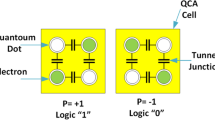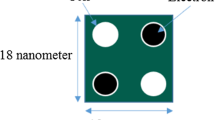Abstract
Quantum dot cellular automata (QCA) technology is considered as one of the most suitable replacements to reduce the CMOS-based digital circuit design problems at the nanoscale due to its tiny size, fast, latency and very low power consumption. One of the main components of microprocessors is the arithmetic logic unit (ALU) and in other words, it acts as the heart of microprocessors. This paper presents a QCA technology-based reversible ALU unit using basic reversible blocks and a novel reversible block namely BS1 Block. The proposed block performs logic and arithmetic operations in the proposed scheme. The simulations of the proposed design are carried out by QCA Designer. According to the simulated results, the proposed structure has a 35%, 27% and 30% improvement in quantum cost, the number of cells and the occupied area in comparison to the previous conducted researches, respectively.













Similar content being viewed by others
Change history
15 June 2021
A Correction to this paper has been published: https://doi.org/10.1007/s11227-021-03933-y
References
Landauer R (1961) Irreversibility and heat generation in the computational process. IBM J Res Dev 5:183–191
Bennett C (1973) Logical reversibility of computation. IBM J Res Dev 17:525–532
Das JC, De D (2019) Novel design of reversible priority encoder in quantum dot cellular automata based on Toffoli gate and Feynman gate. J Supercomput 75:6882–6903
Sasamal TN, Singh AK, Mohan A (2016) Efficient design of reversible alu in quantum-dot cellular automata. Optik, p 6172–6182
Das JC, De D (2015) Novel low power reversible binary incrementer design using quantum-dot cellular automata. Microprocess Microsyst 42:10–23
Sousa L (2021) Nonconventional computer arithmetic circuits, systems and applications. IEEE Circ Syst Mag 21:6–40
Bishop D (2005) Nanotechnology and the end of Moore’s law. Bell Labs Tech J 10:23–28
Roohi A, DeMara R, Khoshavi N (2015) Design and evaluation of an ultra-area-efficient fault-tolerant QCA full adder. J Microelectron 46:531–542
Sabbaghi-Nadooshan R, Kianpour M (2014) A novel QCA implementation of MUX-based universal shift register. Comput Electron
Moharrami E, Jafari Navimipour N (2017) Designing nanoscale counter using reversible gate based on quantum-dot cellular automata. Int J Theor Phys, pp 1060–1081
Ahmad F, Bhat G (2012) Novel code converters based on quantum-dot cellular automata (QCA). Journal of Science and Research, p. 364–371, 2012.
M. Sarvaghad-Moghaddam, Orouji AA (2018) A new design and simulation of reversible gates in quantum-dot cellular automata technology
Walus K, Dysart T, Jullien G, Budiman R (2004) QCADesigner: a rapid design and simulation tool for quantum-dot cellular automata. IEEE Trans Nanotechnol 3(1):26–31
Bahar A, Rahman M, Nahid N, Hassan M (2017) Energy dissipation dataset for reversible logic gates in quantum dot-cellular automata. Data Brief 10:557–560
Bahrepour D, Forouzanfar J (2016) A novel robust macrocell based on quantum dot cellular automata. Quantum Matter 5:689–696
Douglas TP, Lent CS (1994) Logical devices implemented using quantum cellular automata. J Appl Phys 75:1818–1825
Islam M (2009) Synthesis of fault tolerant reversible logic circuits in testing and diagnosis. In: IEEE Circuits and Systems International Conference
Lewandowski M, Ranganathan N, Morrison M (2013)Behavioral model of integrated qubit gates for quantum reversible logic design. VLSI (ISVLSI). In: IEEE Computer Society Annual Symposium
Mamun M, Al S, Menville D (2014) Quantum cost optimization for reversible sequential circuit
Agrawall NC, Kumar A, Jaiswal A (2017) Implementation of reversible control and full adder unit using hng reversible logic gate. Int J Res Appl Sci Eng Technol IJRASET 5:475–480
Haghparast M, Navi K (2008) A Novel Reversible BCD Adder For Nanotechnology Based Systems. Am J Appl Sci 5(3):282–288. https://doi.org/10.3844/ajassp.2008.282.288
Mrinal G, Sen B, Mukherjee R, Sikdar B (2017) Design of testable adder in quantum-dot cellular automata with fault secure logic. Microelectron J 60:1–12
Mr G, Navimipour N (2018) A new three-level fault tolerance arithmetic and logic unit based on quantum dot cellular automata. Microsyst Technol, pp 1–11
Armin N, Houshmand M (2017) Design and simulation of a reversible ALU by using QCA cells with the aim of improving evaluation parameters. J Comput Electron 16:883–895
Dutta SBM, Goswami M, Sikdar B (2014) Modular design of testable reversible ALU by QCA multiplexer with increase in programmability. Microelectron J, pp 1522–1532
Chaves JF, Silva D, Camargos V (2015) Towards reversible QCA computers: reversible gates and ALU. In: IEEE 6th Latin American Symposium on Circuits and Systems, pp 1–4
Oskouei S, Ghaffari A (2019) Designing a new reversible ALU by QCA for reducing occupation area. J Supercomput, pp 5118–5144
Heikalabad NMS, Salimzadeh F (2020) A reversible ALU using HNG and Ferdkin gates in QCA nanotechnology. Int J Circ Theor Appl, pp 1–13
Author information
Authors and Affiliations
Corresponding author
Additional information
Publisher's Note
Springer Nature remains neutral with regard to jurisdictional claims in published maps and institutional affiliations.
Rights and permissions
About this article
Cite this article
Safaiezadeh, B., Mahdipour, E., Haghparast, M. et al. Novel design and simulation of reversible ALU in quantum dot cellular automata. J Supercomput 78, 868–882 (2022). https://doi.org/10.1007/s11227-021-03860-y
Accepted:
Published:
Issue Date:
DOI: https://doi.org/10.1007/s11227-021-03860-y




